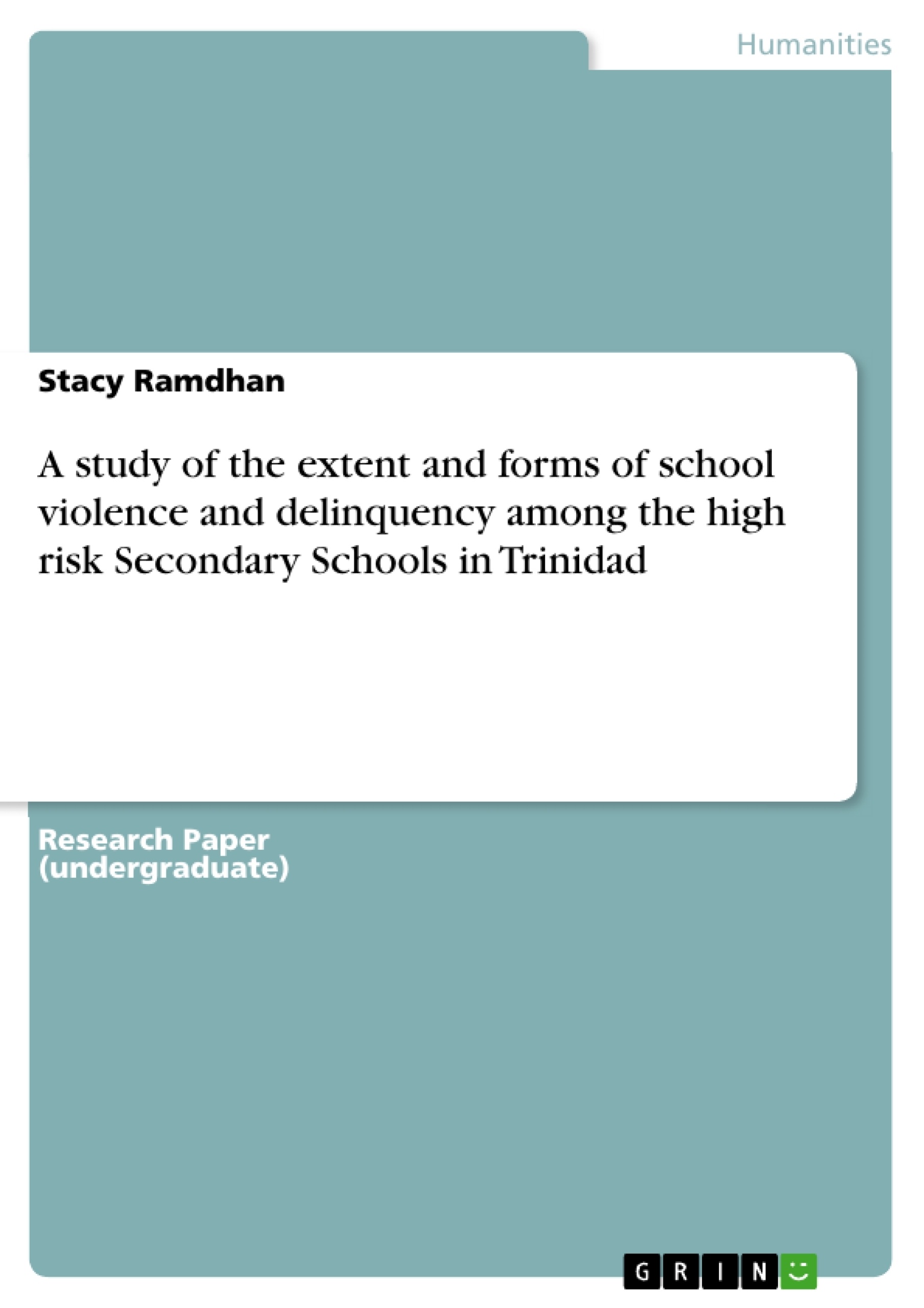The aims of the study is to understand the real life conditions and experiences of children together with the extent and forms of school violence in the Secondary Schools in Trinidad among whom the highest incidences of violence have been reported, and if possible to construct an adequate theory about the upsurge in crime in this youthful section of the population using the dynamics of race, gender, social class, limited opportunity for employment, poverty and family background.
The objective of the research is to investigate the experiences of students in the Secondary School system in the high risk schools in Trinidad, and to enquire into their perceptions/experiences of the root causes, consequences and outcomes of youth engagement in violence. A further objective is to propose policies and recommendations to address the root problems of school violence and delinquency exposed by the research to reduce the levels of crime and violence in the high risk schools. In addition to recommend polices/ strategies to strengthening student protection, school staff, families and the community as a whole.
The increase in criminal behavior among the Secondary School population in Trinidad and Tobago has been of national concern for some time. Reports of serious crime – murder, attack with a weapon, rape, larceny, kidnapping - allegedly committed by school students and reported in the press, have given rise to great concern and stimulated resultant explanations from lay persons and policy makers alike. The reasons for and the appropriate methods of dealing with this relatively new phenomenon in the Trinidad context, have abounded and are discussed in various public fora.
Inhaltsverzeichnis (Table of Contents)
- Aims
- Objectives/Purpose of the Study
- Problem Definition/Statement of the Problem
- Introduction
- Definitions
- Theoretical Explanations
- Literature Review/Background
- Methodology
- Conclusion and Discussion
- Recommendations
- Bibliography
Zielsetzung und Themenschwerpunkte (Objectives and Key Themes)
The study aims to understand the extent and forms of school violence and delinquency among high-risk secondary schools in Trinidad. The research will investigate the experiences of students in these schools and delve into their perceptions of the root causes, consequences, and outcomes of youth engagement in violence. The study further aims to propose policies and recommendations to address the root problems of school violence and delinquency identified by the research, reducing crime and violence levels in these high-risk schools and strengthening student protection, school staff, families, and the community as a whole.
- Youth violence and delinquency in Trinidad's secondary schools
- Root causes of school violence and delinquency
- Experiences and perceptions of students in high-risk schools
- Policy recommendations to address school violence and delinquency
- Strengthening student protection, school staff, families, and the community
Zusammenfassung der Kapitel (Chapter Summaries)
- Aims: This chapter outlines the main objectives of the study, focusing on understanding the realities of school violence in Trinidad's secondary schools and exploring the factors contributing to its rise. The aim is to develop a comprehensive theory about the upsurge in crime among youth by analyzing the dynamics of race, gender, social class, employment opportunities, poverty, and family background.
- Objectives/Purpose of the Study: This chapter details the research objectives, emphasizing the investigation of students' experiences in high-risk secondary schools. The study seeks to uncover their perspectives on the root causes, consequences, and outcomes of youth involvement in violence and propose policies to address these issues, ultimately aiming to reduce crime and violence in these schools and strengthen the protective mechanisms for students, staff, families, and the community.
- Problem Definition/ Statement of the Problem: This chapter highlights the growing concern surrounding the increase in criminal behavior among secondary school students in Trinidad and Tobago. The chapter examines the nature of these crimes, including murder, assault, rape, theft, and kidnapping, and discusses the national concern arising from these reports. It analyzes the reasons behind this phenomenon and explores the various approaches proposed for addressing it.
- Introduction: This chapter provides definitions of key concepts, including violence, crime, violent crime, delinquency, and juvenile crime. It delves into the definitions of adolescence and youth, and the concept of "at-risk youth," highlighting the socio-economic factors impacting their development. The chapter also addresses the recognition of youth violence as a significant macro-economic problem due to its social and economic costs and discusses the complex and diverse causes of crime, including age, gender, race, poverty, environment, family background, crime reduction policies, and economic factors.
- Theoretical Explanations: This chapter explores various theories explaining the apparent rise in youth crime and violent behavior in Trinidad. The chapter examines theories attributing the rise in violence to factors such as poverty, family, social class, gender, race, age, and changes in societal morals and values, highlighting the role of religion and punishment systems in shaping behavior. It discusses the contributions of Cloward and Ohlin's theory of delinquent gangs and Cohen's theory of delinquent cultures, emphasizing the concept of status frustration and the emergence of delinquent subcultures. Finally, the chapter examines critical perspectives on these theories, including Taylor, Walton, and Young's critiques and Ken Pryce's insights on crime in developing societies.
Schlüsselwörter (Keywords)
The study focuses on the critical issue of school violence and delinquency in Trinidad's secondary schools. It examines the socio-economic factors, cultural dynamics, and theoretical perspectives influencing youth involvement in violence. The research aims to develop effective policies and strategies to address these challenges, emphasizing the importance of strengthening protective measures for students, staff, families, and the community.
- Quote paper
- BSc, MSc Stacy Ramdhan (Author), 2010, A study of the extent and forms of school violence and delinquency among the high risk Secondary Schools in Trinidad, Munich, GRIN Verlag, https://www.grin.com/document/175786



